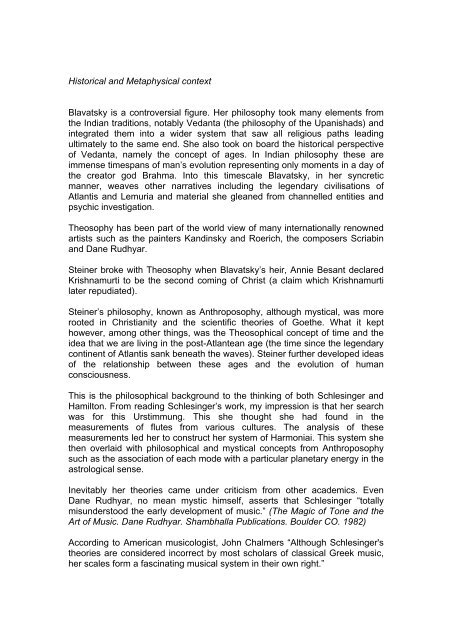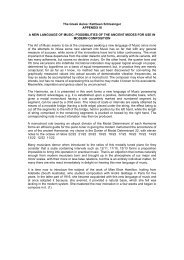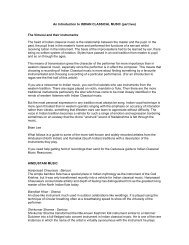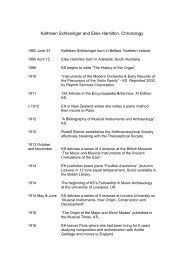Kathleen Schlesinger and Elsie Hamilton - Pioneers of ... - Naked Light
Kathleen Schlesinger and Elsie Hamilton - Pioneers of ... - Naked Light
Kathleen Schlesinger and Elsie Hamilton - Pioneers of ... - Naked Light
You also want an ePaper? Increase the reach of your titles
YUMPU automatically turns print PDFs into web optimized ePapers that Google loves.
Historical <strong>and</strong> Metaphysical contextBlavatsky is a controversial figure. Her philosophy took many elements fromthe Indian traditions, notably Vedanta (the philosophy <strong>of</strong> the Upanishads) <strong>and</strong>integrated them into a wider system that saw all religious paths leadingultimately to the same end. She also took on board the historical perspective<strong>of</strong> Vedanta, namely the concept <strong>of</strong> ages. In Indian philosophy these areimmense timespans <strong>of</strong> man’s evolution representing only moments in a day <strong>of</strong>the creator god Brahma. Into this timescale Blavatsky, in her syncreticmanner, weaves other narratives including the legendary civilisations <strong>of</strong>Atlantis <strong>and</strong> Lemuria <strong>and</strong> material she gleaned from channelled entities <strong>and</strong>psychic investigation.Theosophy has been part <strong>of</strong> the world view <strong>of</strong> many internationally renownedartists such as the painters K<strong>and</strong>insky <strong>and</strong> Roerich, the composers Scriabin<strong>and</strong> Dane Rudhyar.Steiner broke with Theosophy when Blavatsky’s heir, Annie Besant declaredKrishnamurti to be the second coming <strong>of</strong> Christ (a claim which Krishnamurtilater repudiated).Steiner’s philosophy, known as Anthroposophy, although mystical, was morerooted in Christianity <strong>and</strong> the scientific theories <strong>of</strong> Goethe. What it kepthowever, among other things, was the Theosophical concept <strong>of</strong> time <strong>and</strong> theidea that we are living in the post-Atlantean age (the time since the legendarycontinent <strong>of</strong> Atlantis sank beneath the waves). Steiner further developed ideas<strong>of</strong> the relationship between these ages <strong>and</strong> the evolution <strong>of</strong> humanconsciousness.This is the philosophical background to the thinking <strong>of</strong> both <strong>Schlesinger</strong> <strong>and</strong><strong>Hamilton</strong>. From reading <strong>Schlesinger</strong>’s work, my impression is that her searchwas for this Urstimmung. This she thought she had found in themeasurements <strong>of</strong> flutes from various cultures. The analysis <strong>of</strong> thesemeasurements led her to construct her system <strong>of</strong> Harmoniai. This system shethen overlaid with philosophical <strong>and</strong> mystical concepts from Anthroposophysuch as the association <strong>of</strong> each mode with a particular planetary energy in theastrological sense.Inevitably her theories came under criticism from other academics. EvenDane Rudhyar, no mean mystic himself, asserts that <strong>Schlesinger</strong> “totallymisunderstood the early development <strong>of</strong> music.” (The Magic <strong>of</strong> Tone <strong>and</strong> theArt <strong>of</strong> Music. Dane Rudhyar. Shambhalla Publications. Boulder CO. 1982)According to American musicologist, John Chalmers “Although <strong>Schlesinger</strong>'stheories are considered incorrect by most scholars <strong>of</strong> classical Greek music,her scales form a fascinating musical system in their own right.”





